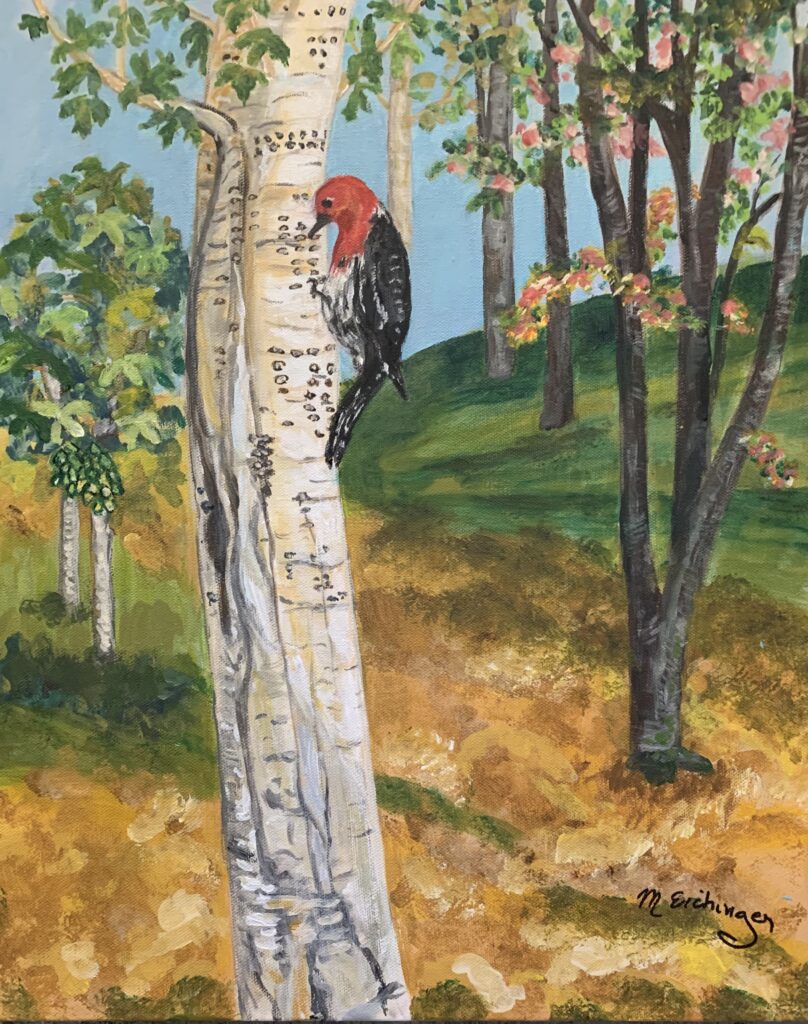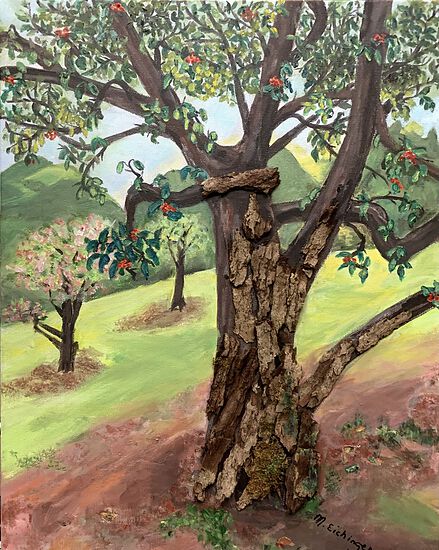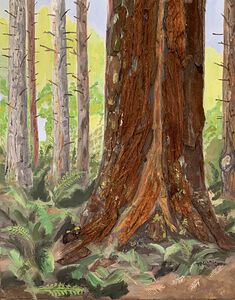An Update on Trees



I love trees, especially old-growth ones with limbs twisted and knarled like elders. I was even more enthralled after discovering they communicate for protection against insects and nurture young seedlings. I’ll go out of my way to walk past maritime pines with bark like the plates on an armadillo. I’m fascinated by the holes woodpeckers make in rings around pawpaw trees. How do they manage to keep them in line?
Forests are calming, unique places to go to view the variety in nature and to be filled with inspiration. I become upset when returning home and read they are being decimated. I decided to dig into the current state of tree growth worldwide. What I discovered surprised me.
The United States accounts for 8-10 percent of the world’s forests, with approximately 228 billion trees. According to the North American Forest Commission, that number is two-thirds the amount here in 1600. As cities grew and acreage was added to their boundaries, farmlands and forested areas were converted to cement and asphalt pavings and housing. With 89 percent of the population projected to live in urban areas by 2030, it is likely that urban forests will be decimated by then.
The east coast began adding back forests in the 1940s where woodlands had been heavily logged. Reforesting succeeded when the forest department gained control over how much timber could be cut annually. Designating national parks played a role in preserving woodlands teeming with biodiversity. Though the U.S. replants its forests, the story worldwide is different.
Dr. Thomas Crowther, while a fellow In Forestry and Environmental Sciences at Yale (2015), organized crews to count trees in given geographic locations around the globe. He compared the information his team collected with satellite imaging and came up with the best survey known to date. His estimates show approximately 3.04 trillion trees on the planet today, half as many as when homo sapiens first appeared.
Though Dr. Crowther’s numbers make it seem like there are a lot of trees worldwide, there’s a huge catch. Demand for wood is continuing to grow along with the population. We currently harvest 15 billion trees annually but only re-plant five billion. With a net loss of 10 billion a year, our forests will be gone within the next 300 years. Deforestation is one of the greatest challenges facing humanity as agricultural expansion in the tropics swallows up vast parts of the rainforest.
Climate change, however, is allowing trees to grow in places previously too cold for their survival. Russia added 790,000 square kilometers of trees and China 324, helping to balance the number lost in Brazil if you ignore biodiversity. Foresters remove eight or more species in clear cuts but replant with a single species. Their methods erode the ecosystem, degrade soil, and make forests susceptible to disease and fire. Activists label monoculture tree plantations to be “green deserts.” Such plantations have expanded fivefold since 1980, killing the flora and fauna in tropical forests and savannas forever.
Trees grow faster as global temperatures rise and growing seasons lengthen –not good news. A study of central Europe’s forests shows that pollution and higher temperatures make wood weaker. The trees break more easily in storms, the lumber produced is less dense and less durable, and the amount of CO2 given off drops. Trees are soaking up less CO2 from the atmosphere each year.
Oregon lost 1.1 million acres of trees in 2022 due to drought and extreme heat. At first, it was thought that the deaths were due to fungi and insect infestations. Scientists now agree it’s because of climate change. Though more obvious in fir trees where they die from the tip of their leaves and roots inward, all species show signs of stress. The western red cedar’s range will soon disappear at lower elevations west of the Cascades and western Washington and move north. Forest entomologist, Christine Buhl warns to start shifting expectations of what tree species to plant in the state. for those common in California will move to our region.
It is a lot to take in, but the following are a few additional tidbits of information.
a) Trees are the world’s longest-living species. Some of California’s giant sequoias and Bristlecone pines are between 3,000 and 5000-years-old.
b) Planting trees in urban areas lower vandalism, graffiti, and littering.
c) The earth will receive an additional 260 million tons of oxygen and remove 10 million tons of CO2 by planting 20 million trees.
d) Trees that grow in the sun have thicker bark than those in the shade.
e) Patients with a view of green trees from their hospital bed, spend 8% less time in the hospital than those who don’t.
f) Customers spend more money in shopping districts with trees. They stay longer and perceive products and stores as being of higher quality.
g) Tree limbs are not exactly spherical. They feature an upper (compression) and lower (tension) side that allows them to sustain their own weight as well as the weight of the leaves, nuts, or fruits dangling in mid-air.
h) Utah is home to the world’s oldest clonal tree cluster. According to DNA tests, the Pando group of quaking aspens is roughly 80,000 years old, wishing over 6,000 tons. . It features over 40,000 stems that are branches of a single tree. It is only the world’s oldest living creature but also the biggest.
i) A 2022 threat assessment of 881 native tree species in the U.S. shows that 11-16% are threatened with invasive pests and diseases. The most threatened are Oaks and Hawthorns.
j) The tallest in Redwood Mountain Grove is as tall as a 31-story building, the Widest is in Kings Canyon National Park with a circumference the length of two Toyota Priuses, and the Biggest Tree in Sequoia National Park weighs the same as 107 elephants.
Please share your observations of trees in your area and let followers of this newsletter know about your favorite parks. Comment on my blog below.
I do hope you find time to enjoy outings to national and state parks and forests. If the weather is too cold or wet, you are invited to “Walk in the Woods with me this April at Lake Oswego Library. Twenty-six of my tree paintings will be on display during the Arbor Month exhibit.
16″ X 20″ Canvas prints of the originals are on sale and delivered to your door for $99. Choose your favorites to make your own forest walk. Go to https://www.eichingerfineart.com/collections/182747. Click on the ones you like. Purchasing is easy.
References:
How Many Trees are in the World Today vs 1000 Years Ago? retrieved from The Environmentor.https://blog.tentree.com/fact-check-are-there-really-more-trees-today-than-100-years-ago/#:~:text=Changes%20in%20the%20Last%20Hundred,had%20in%20the%20year%20160
Supriya, L. (2018) Climate change is making trees big, but weaker. Science.
Earth-has more trees than it did 35 years ago- but there’s a huge catch. World Economic Forum . retrieved from https://www.weforum.org/agenda/2018/08/planet-earth-has-more-trees-than-it-did-35-years-ago/
Firmageddon” Researhers find 1.1 million acres of dead trees in Oregon.News. retrieved from https://www.nbcnews.com/science/environment/firmageddon-researchers-find-11-million-acres-dead-trees-oregon-rcna59671
Kilgore, G. (2022) How Many trees Are in the United States? Shocking Stats. RForestry, Trees, and Tree Planting. retrieved from https://8billiontrees.com/trees/how-many-trees-are-in-the-united-states/
NatureSuErve website. (2022) Researchers complete first comprehensive threat assessment of all U.S. trees. retrieved from https://www.natureserve.org/news-releases/researchers-complete-first-comprehensive-threat-assessment-all-us-trees
Hance, H. (2008) Monoculture tree plantations are “ green deserts” not forests, say Activists.Mongabay; news and inspiration from Nature’s Frontline. retrieved from https://news.mongabay.com/2008/09/monoculture-tree-plantations-are-green-deserts-not-forests-say-activists/
